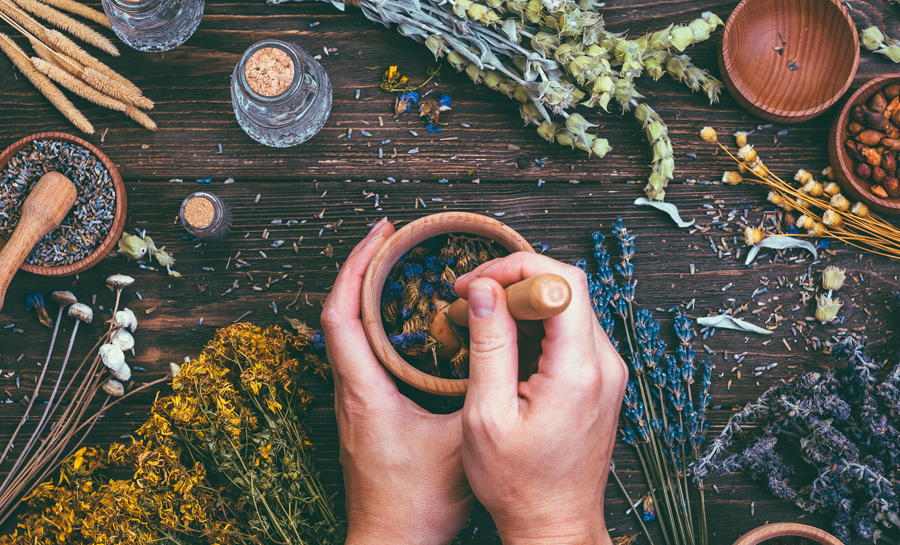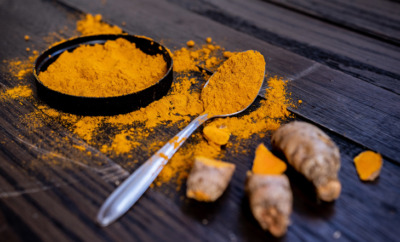What Is Ayurveda? Here’s a Crash Course in Everything You Need to Know

Ayurveda can be defined as “The science of life or knowledge of life.” Ayurveda is an ancient system for living, closely connected to yoga since it originated in India and has been around for almost as long.
Essentially, Ayurveda is a holistic art and science that utilizes natural herbs, roots, and minerals to promote well-being and balance.
This article will explore the main components of Ayurveda and living an Ayurvedic lifestyle. Ready for your crash course? Let’s dive in!
First Things First – Ayurveda is All About the Elements
According to Ayurveda, everything in existence, including us, comes from five elements or basic building blocks. These are: Earth, Fire, Water, Air, and Space.
Psst! Want to flow with the elements? We have a yoga video course for that! Check out our exclusive Earth Elements Yoga with Yoga Journal cover girl Jennifer Pansa!
When these elements are paired together, they form ‘Doshas’ or the constitutions that influence our health, wellbeing, habits, personality and behaviors. There are three doshas: Vata (Air and Space), Pitta (Fire and Earth) and Kapha (Earth and Water).
Want to learn more about the Doshas and how they control our physical and mental behaviors? Check out What Are the Doshas: Everything You Need to Know
There Are Two Key Concepts in Ayurveda
There are two key concepts that are fundamental to the holistic wellness approach of Ayurveda: Agni and Prana.
Agni is our digestive ‘fire.’ It is important because an Ayurvedic lifestyle aims to stoke our internal furnace and fuel that digestive fire to ensure our food is digested efficiently. This is important so all the nutrients can effectively nourish our bodies and all waste product is evacuated completely to ensure minimum toxicity remains within our bodies.
Prana is our vital life force energy. Prana is the very life force that flows through all living things. Ayurveda provides ways of optimizing this energy through diet and lifestyle, with specific emphasis on warm, hearty and whole foods and a daily routine that corresponds to the needs of our body’s natural rhythm.
Prana is a fascinating part of all existence. Learn more! Check out Demystifying Prana – Everything You Need to Know About Life Force Energy
Now You’re Ready to Learn About Your Dosha
As we discussed above, there are three main doshas, and these dictate your unique characteristics and tendencies. Read about each one to discover what your dosha is!
1. Vata Dosha
The qualities of Vata are cold, light, dry, irregular, rough, moving, quick and changeable, making Vata people lively and enthusiastic, slim and wiry, with angular features.
When Vata is balanced, they are creative and social. When imbalanced, a Vata person will suffer with nervous disorders such as anxiety and their digestion will become erratic.
2. Pitta Dosha
The qualities of Pitta are hot, light, intense, pungent, sharp and acidic. The Pitta dosha controls our digestion, metabolism and energy production. Pitta people build muscle more easily, have bright complexions, and a piercing gaze. They are naturally fiery in nature.
When in balance, Pittas are content and clear minded. They make good leaders and organizers. When unbalanced, Pitta people can become dominating, angry and argumentative. They will suffer from indigestion, excessive body heat, heartburn or acne.
3. Kapha Dosha
The qualities of Kapha are heavy, slow, steady, solid, cold, soft, and oily. A Kapha person is steady in nature. They have a strong build but there is also a softness to them.
When in balance, a Kapha person is steady, forgiving, courageous, generous, affectionate, serene, calm, thoughtful, loving, loyal, patient and supportive. However, when out of balance, a Kapha person might suffer from weight gain, fluid retention, allergies, depression and lethargy, as well as being resistant to change.
According to Ayurveda, our Prakriti is our baseline constitution, or dosha balance, at birth. For optimal health, it’s recommended we seek to maintain our Prakriti and harmonize the doshas within the body through diet and lifestyle modifications, since imbalance can manifest as illness or even disease.
To find out your dosha, you can take an online quiz such as this one.
Why Food is So Important in Ayurveda
The real secret of Ayurveda is the emphasis on food for well-being. We know that food is life. Without it, we simply would not survive. But Ayurveda also teaches us that it has the potential for us to thrive when we eat nourishing, nurturing meals that feed our bellies, hearts and minds.
Unlike many Western approaches to diets that focus on proteins and carbohydrates etc., Ayurveda looks at what we eat from the perspective of six tastes:
Sweet, Salty, Sour, Bitter, Pungent and Astringent
Not only do each of these play a specific role within the body, it is said that when our meals are complete (i.e. they contain all six tastes), we are able to leave the dinner table satisfied, feeling nourished and whole to our very soul, so we’re not left reaching for that ‘something’ that is missing (usually in the form of chocolate, carbs, or salty snacks).
Next time you step into the kitchen to prepare a meal, keep this approach in mind and see what it does for you!
Follow the Natural Rhythm of Ayurveda For Optimal Wellbeing
Another thing that you may not know is that Ayurveda recognizes that we have an internal bodily rhythm that is mirrored or matched by the cycles outside of ourselves in nature.
There are three cycles during the day and three cycles at night. Each cycle is a combination that contains two of the five elements: Ether, Air, Fire, Water, and Earth.
6:00 am – 10:00 am: Kapha (Water-Earth)
Your body may feel a bit slow or heavy during this these hours and your digestive fire is generally lower, especially if you ate a late dinner the night before. This Kapha period is a good time to do light exercise and ignite metabolism.
10:00 am – 2:00 pm: Pitta (Fire-Water)
Digestive fire reaches its peak during this time, so it’s the best time to eat a bigger meal. It is also when you are at your most productive.
2:00 pm – 6:00 pm: Vata (Ether-Air)
In this part of the afternoon, the body generally becomes light and the mind clear. This is a great time for creative activities.
6:00 pm – 10:00 pm: Kapha (Water-Earth)
The body naturally wants to unwind from the day. By late evening, the body becomes heavier and begins to prepare for sleep. Therefore, it’s best to be in bed and ready to sleep by 10pm.
10:00 pm – 2:00 am: Pitta (Fire-Water)
The evening meal digests along with the day’s activities, thoughts, feelings and experiences.
2:00 am – 6:00 am: Vata (Ether-Air)
This is when deep dream sleep occurs. Imbalances within the body will usually manifest during this time in the form of waking up to use the bathroom, tossing and turning, etc. Waking up to start your day around 6am ensures a graceful entry into the new day.
If you’re having trouble sleeping, falling asleep or staying asleep, try this Simple Bedtime Yoga Sequence For Restful Sleep
Ayurveda as a Healthy Lifestyle
I remember when I was first introduced to Ayurveda. It really helped me to understand myself. Characteristics or physical quirks I’d always felt frustrated by suddenly made sense. Safe in the knowledge that these things were just part of me and my true nature, I began to work with who I was rather than resist.
By looking at how I ate and how I lived my life I was able to create more balance than I’d ever had before. Ultimately my life really improved for the better. I felt more grounded, had more energy and for the first time in my life, I felt truly well.
Ayurveda has been a tried and true method for thousands of years. This science of life gives us the knowledge we need to keep the human system balanced, harmonized, and happy. To happiness and health the Ayurvedic way!


This Month's Letter
From the Editor
Monthly motivation and food for
thought from our founder.






























Comments